Circle
of confusion
In optics, a circle of confusion, (also known as disk of confusion,
circle of indistinctness, blur circle, etc.), is an optical spot caused
by a cone of light rays from a lens not coming to a perfect focus when
imaging a point source.
Experiment
(just like high school science class): Take a magnifying glass and hold
it so that a light shines through it onto a sheet of paper. You could
use the sun but you are apt to burn up your experiment. An overhead
light bulb is better. If it has writing stamped on it that you can focus
on, that's great. Move the glass (or paper) until the light bulb makes
a distinct image on the paper. Move it up and down to observe how the
light spreads as the image gets further out of focus. As the light spreads
you are seeing circles of confusion.
How it works
To understand the Circle of Confusion you must first remember that
lightis reflected off the subject in all directions (exception: specular
highlights which reflect within a narrow angle). Your camera will gather
all the light rays from each point on the subject which are reflected
toward the camera and fall within the circle created by the opening
of the diaphragm. You may visualize this as a cone of light which has
its apex at the point of reflectance on the subject and it's circular
base in the diaphragm opening.
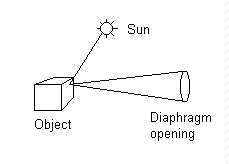
If the lens is focused on the point from which these rays are being
reflected, the lens will bend the rays back in an inverted cone of light
inside the camera with its apex creating a point of light on the film
plane.
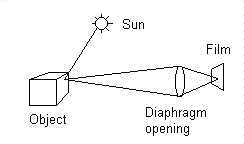
When the lens is focused on a nearer or farther distance the point
will fall in front of or behind the film plane. If the rays come to
a point in front of the film plane and they will cross into another
cone until it strikes the film.
In this case the base of this 3rd cone registers on the film as a circle
of light rays which are not in register. This circle of unfocused light
rays is a circle of confusion.
Of course it also occurs when the lens is positioned so that the point
where the light rays converge beyond the film plane. The film interrupts
the cone of light before it reaches its apex and registers as the circle
of the cone's diameter where it was truncated.
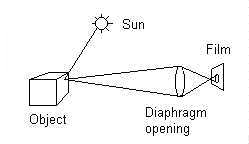
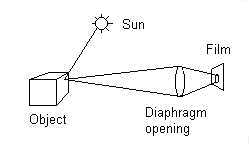
Since the angle of the cone of light is determined by the diameter
of the diaphragm opening, the diameter of the circle of confusion is
affected by changes in the diaphragm opening. Smaller diaphragm openings
produce narrower angles in the cone, therefore smaller bases (smaller
circles of confusion).
That is why "stopping down" increases depth-of-field.
Theoretically, everything in a photograph except the exact plane on
which the lens was focused registers in varying degrees of un-focus
(smaller or larger circles of confusion). In practical terms neither
the film nor our eyes are capable of registering such fine detail so
we are really concerned with the circles of confusion that are large
enough to see. We want circles of confusion which are too small to see
thereby creating the impression of sharpness. The smallest point which
the eye can detect is approximately .01 inch.
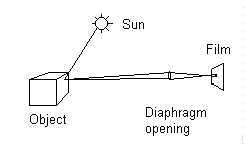
This discussion has dealt with only the light from a single point on
the subject. In real photography the same thing is happening with all
the light rays from all points on our subject all at the same time.
The focused rays are aligned by the lens to create the sharp areas of
the image. The unfocused rays scatter and merge into one another making
blurred images of overlapping circles.
Trivia note: If you own a mirror telephoto your circles of confusion
are literally circles. The first mirror which gathers the light from
the subject is a ring around the light path from the secondary mirror
to the film. Light from parts of the view which are out of focus, record
on the film as rings because they are not fully gathered to a point
from the ring mirror. The effect is especially noticeable in bright
highlights.
Before anyone sends me e-mail saying "who cares", please
remember that I warned you on the lessons index that it was more than
you really wanted to know (and you did read it all).
See also the lessons on Depth-of-field, Image sharpness. and Lenses
Back to Lessons Index
Two other
factors play a part in depth of field:
subject distance
focal length
Want to learn more? - do a workshop or one on one with Lloyd Godman